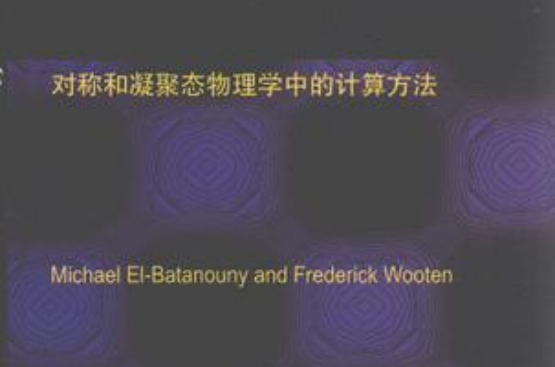《對稱和凝聚態物理學中的計算方法》是2012年世界圖書出版公司出版的圖書,作者是巴塔努尼。
基本介紹
- 書名:對稱和凝聚態物理學中的計算方法
- 作者:巴塔努尼
- ISBN:9787510042812
- 頁數:922
- 定價:165.00元
- 出版社:世界圖書出版公司
- 出版時間:2012-3
內容簡介
目錄
1 symmetry and physics
1.1 introduction
1.2 hamiltonians, eigenfunctions, and eigenvalues
1.3 symmetry operators and operator algebra
1.4 point-symmetry operations
1.5 applications to quantum mechanics
Exercises
2 symmetry and group theory
2.1 groups and their realizations
2.2 the symmetric group
2.3 computational aspects
2.4 classes
2.5 homomorphism, isomorphism, and automorphism
2.6 direct- or outer-product groups
Exercises
3 group representations: concepts
3.1 representations and realizations
3.2 generation of representations on a set of basis functions
Exercises
4 group representations: formalism and methodology
4.1 matrix representations
4.2 character of a matrix representation
4.3 burnside's method
Exercises
computational projects
5 dixon's method for computing group characters
5.1 the eigenvalue equation modulo p
5.2 dixon's method for irreducible characters
5.3 computer codes for dixon's method
appendix 1 finding eigenvalues and eigenvectors
exercises
appendix 2
computation project
6 group action and symmetry projection operators
6.1 group action
6.2 symmetry projection operators
6.3 the regular projection matrices: the simple characteristic
Exercises
7 construction of the irreducible representations
7.1 eigenvectors of the regular rep
7.2 the symmetry structure of the regular rep eigenvectors
7.3 symmetry projection on regular rep eigenvectors
7.4 computer construction of irreps with ds ]1
7.5 summary of the method
Exercise
8 product groups and product representations
8.1 introduction
8.2 subgroups and cosets
8.3 direct outer-product groups
8.4 semidirect product groups
8.5 direct inner-product groups and their representations
8.6 product representations and the clebsch-gordan series
8.7 computer codes
8.8 summary
Exercises
9 induced representations
9.1 introduction
9.2 subduced reps and compatibility relations
9.3 induction of group reps from the irreps of its subgroups
9.4 irreps induced from invariant subgroups
9.5 examples of irrep induction using the method of little-groups
appendix frobenius reciprocity theorem and other useful theorems
exercises
10 crystallographic symmetry and space-groups
10.1 euclidean space
10.2 crystallography
10.3 the perfect crystal
10.4 space-group operations: the seitz operators
10.5 symmorphic and nonsymmorphic space-groups
10.6 site-symmetries and the .wyckoff notation
10.7 fourier space crystallography
Exercises
11 space-groups: irreps
11.1 irreps of the translation group
11.2 induction of irreps of space-groups
Exercises
12 time-reversal symmetry: color groups and the onsager relations
12.1 introduction
12.2 the time-reversal operator in quantum mechanics
12.3 spin-l/2 and double-groups
12.4 magnetic and color groups
12.5 the time-reversed representation: theory of corepresentations
12.6 theory of crystal fields
12.7 onsager reciprocity theorem (onsager relations) and transport properties
Exercises
13 tensors and tensor fields
13.1 tensors and their space-time symmetries
13.2 construction of symmetry-adapted tensors
13.3 description and classification of matter tensors
13.4 tensor field representations
Exercises
14 electronic properties of solids
14.1 introduction
14.2 the one-electron approximations and self-consistent-field theories
14.3 methods and techniques for band structure calculations
14.4 electronic structure of magnetically ordered systems
appendix i derivation of the hartree-fock equations
appendix 2 holstein-primakoff (hp) operators
exercises
15 dynamical properties of molecules, solids, and surfaces
15.1 introduction
15.2 dynamical properties of molecules
15.3 dynamical properties of solids
15.4 dynamical properties of surfaces
appendix 1 coulomb interactions and the method of ewald summation
appendix 2 electronic effects on phonons in insulators and semiconductors
exercises
16 experimental measurements and selection rules
16.1 introduction
16.2 selection rules
16.3 differential scattering cross-sections in the born approximation
16.4 light scattering spectroscopies
16.5 photoemission and dipole selection rules
16.6 neutron and atom scattering spectroscopies
Exercises
17.1 phase transitions and their classification
17.2 landau theory of phase transitions: principles
17.3 construction and minimization techniques for
Exercises
18 incommensurate systems and quasi-crystals
18.1 introduction
18.2 the concept of higher-dimensional spaces: superspaces and superlattices
18.3 quasi-crystal symmetry: the notion of indistinguishability and the clossification of space-groups
18.4 two-dimensional lattices, cyclotomic integers, and axial stacking
bibliography
references
index

